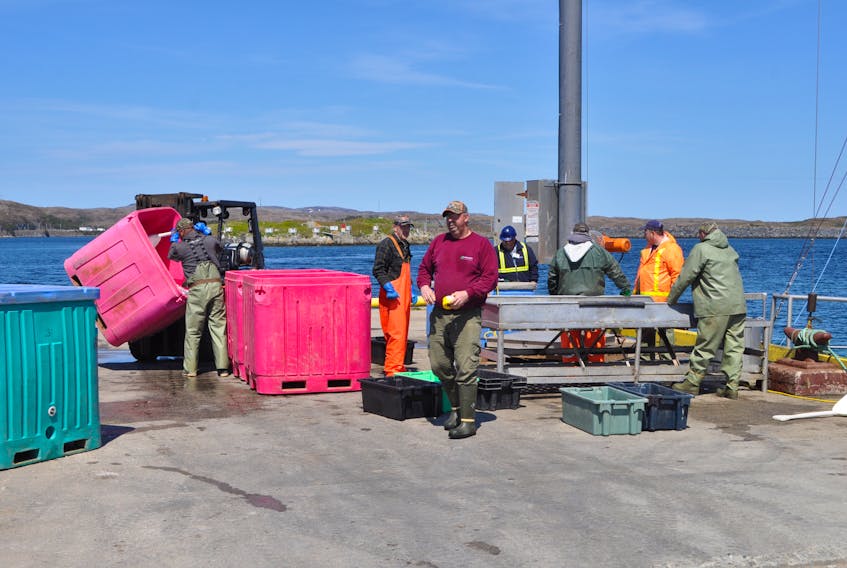SOUTHWEST COAST, N.L. — According to Fish, Food and Allied Workers (FFAW) West Coast representative Jason Spingle, redfish were a popular and prolific species in their heyday.
“It was probably the most prominent fishery back in the ‘60s, ‘70s, ‘80’s on the south and southwest coast,” Spingle said. “Cod was big too, but redfish landings supported the communities’ plants in Burgeo, Ramea, Gaultois and Port aux Basques.”
The redfish depleted along with cod and other groundfish in the late ‘80’s, early ‘90’s.

“It has been at a very low level since, based on the minimum commercial fishery and science surveys,” Spingle noted. “A few years ago, a small bloom of red fish showed up, which is surprising since they (scientists) didn’t think there were a lot of adult red fish to produce it.”
“I guess Mother Nature has its way and can surprise us sometimes,” Spingle said. “They are saying, this is from science, that the recruitment — the small fish that are now undersize because they are slow growing fish — are unprecedented in the Gulf.
“They figure it could be the largest ground fish stock ever in Atlantic Canada when it matures. In excess of five million metric tones. It has great potential as we see it.”
Spingle only knows of two harvesters currently fishing the species along the west coast.
Redfish had resurged to such a degree, the Department of Fisheries and Oceans (DFO) opened a season for catching the species in the NAFO Division of 4R (Unit 1) on June 30. However just six days later, DFO shut that opportunity down again when regulators discovered that too high a percentage of the catch were under 22 centimeters, under the small fish protocol. The fish weren’t mature enough to sustain the species yet. However, the hold on the species could be lifted as the fish mature.
Along the southwest coast, the 3Ps and 3Pn portions of Unit 2 opened for redfish harvesting on July 7. 3Ps then closed on July 19, but the rest of Unit 2 is still open season for harvesters.
Quota system
Spingle explains the current quota system.
“There’s somewhere around 40-45 mobile gear groundfish enterprises that would have access in 4R and 3Pn and what we have right now under the current plan is a designated 200 tones,” he said. “That’s somewhat over 400,000 pounds.
“But shortly after 1995 when this was placed under an index fishery, the department has only allowed four permits to traditional non-shrimpers to have access. It’s just on a competitive component at 200 tones and we haven’t come close to catching it in recent years.
“If you want to break the 200 tones amongst the 40 odd enterprises, it wouldn’t be much and our share in Unit 2 is not that significant either.
Spingle notes there is also an informational quota — where harvesters can help record stats on the fish under the Experimental Redfish Fishing Plan — that all harvesters can apply for. The quota for that program has not been allocated yet.
Impact on shrimp?
Spingle worries that the resurgence of redfish will negatively impact the shrimp fishery since redfish prey on shrimp.
“Shrimp has been the basis for many folks’ livelihood and has been quite good throughout the Gulf,” Spingle said. “The shrimp has taken a down turn and probably will continue to.
“Unfortunately, science has acknowledged it formally that the shrimp has declined due to changes in the environment as well as predation from this incoming red fish.”
He continues, “We’d like to think the shrimp aren’t going to be impacted, but we see this as being part of the future. We hope they aren’t impacted but all the evidence points to there’s going to be less shrimp to catch.”
Spingle says that abundance of certain species seems to come in waves.
“Unfortunately, everything doesn’t seem to be abundant all at once,” Spingle commented. “For a long time cod, redfish and flounder, back in the ‘80’s, that’s what a lot of these harvesters made their living on and that’s what the plants produced.”
Spingle noted in the last 30 years since the moratorium, fishers have really gone to shellfish, namely snow crab and shrimp and now they’re seeing major declines in those.
“I guess that’s part of it, stability lasts only so long, and I think a lot of it is environmentally influenced,” he said. “Redfish is a good example where things looked pretty bleak for such a long period of time and then all of a sudden you have this abundance of fish. Time will tell.”
Mantilla redfish
Spingle has great hopes for a certain species of redfish.
“Mantilla redfish are more abundant,” Spingle noted. “If you can ensure that you are catching more of the mantilla, your quota can be significantly higher.
“If you want to find a way to separate the species, then you are looking at quotas not too far down the road, in excess of a 100 thousand tones.”
He is optimistic and has work to do while waiting for the current crop of fish to mature. “It’s going to be a wait and see and we’re proposing to do some work and tests on gear,” Spingle commented. “We are going to have to build on our markets too, so that’s going to be a challenge.”
The Gulf News contacted representatives of Codroy Seafoods and The Barry Group for insight into whether they are currently processing redfish, if so to what extent, as well as which markets redfish do well in, but received no response from either by print deadline.









